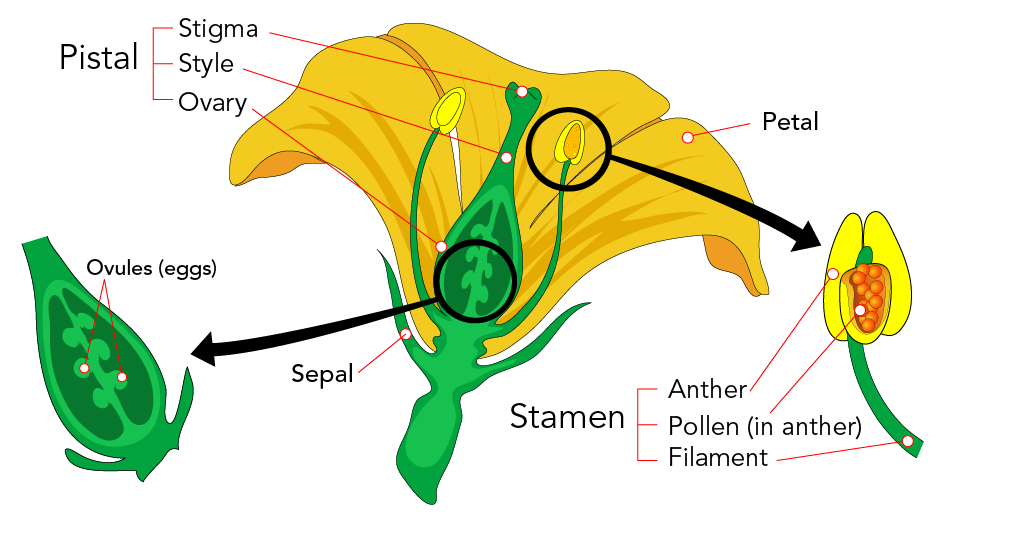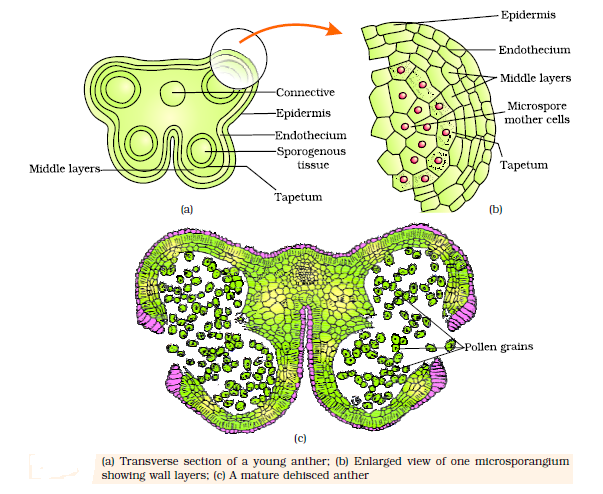CBSE Class 12 Biology Chapter 2 Revision Notes Part 1
Chapter 2: Sexual Repoduction in Flowering Plants Revision Notes Part 1
In flowering plants or angiosperms, sexual reproduction entails the creation of male and female gametes and the transfer of male gametes to female ovules by pollination. Following pollination, fertilization occurs, and the ovules develop into seeds within the fruit. Before understanding sexual reproduction in flowering plants, we need to know about the flower parts which aids in reproduction. Let’s get into it.
The Anatomy of a Flower:
Calyx
The Calyx is the flower’s outermost whorl. Sepals are the individual parts that make up the flower. The calyx encloses the remainder of the flower at the bud stage. They are normally green in color, however, they can also be a color similar to petals in rare cases. The calyx can be prominent or non-existent.
Corolla
The Corolla is the second whorl of the flower, and it has a large number of petals which may be aromatic at times. They are brightly colored, slender, and soft, aiding pollination by attracting animals and insects.
Androecium
The Androecium is the third whorl of a flower’s male reproductive portion consisting of Stamens. Each stamen comprises two parts: the anther and the filament.
-
Anther: An anther is a four-lobed sac-like structure that produces pollen.
-
Filaments: It comprises thread-like structures connected to the anther and helps maintain it in place.
The Microsporangium is the transverse part of the anther that creates a pollen sac. Pollen grains are contained in the pollen sac. The epidermis, endothecium, middle layer, and tapetum are the four layers that surround the microsporangium. The tapetum in the innermost layer nourishes the growing pollen grains.
-
When the anther is young, sporogenous tissues are compactly organized homogeneous cells found in the center of each microsporangium.
-
Microsporogenesis is the reductional division process that results in the development and differentiation of microspores (pollen grains) from microspore mother cells (MMC).
-
The Microspore Tetrad is formed when cells in sporogenous tissues go through meiotic division. The microspore dissociates and transforms into pollen grains when the anther matures and dehydrates.
Gynoecium
The Gynoecium is the flower’s final whorl and the female reproductive organ. It is made up of Pistils, the reproductive part of a flower, and is located in the center of the thalamus. The gynoecium can be either monocarpellary with only one pistil, or multicarpellary with more than one pistil.
The pistil is made up of the Stigma, Style, and Ovary. The ovary is a storage compartment for ovules (eggs) awaiting fertilization. Pollen from other flowers settles on the stigma linked to the top of the carpel. The ovary and the stigma are connected by the style, a tubular structure in charge of transporting pollen from the stigma to the ovary and keeping the stigma in place.
Megasporangium (Ovule)
-
The Megasporangium, or ovule, is little structure linked to the placenta.
-
The Funicle is the stalk that connects the ovule to the placenta.
-
The Hilum is the point where the ovule and the funicle meet.
-
Protective envelopes are known as Integuments.
-
A Micropyle is a tiny hole at the apex of the ovule via which pollen tubes enter.
-
The Chalaza is the portion of the ovule closest to the ground.
-
The Nucellus (2n) is a collection of cells encased in integuments. Has a large food supply.
Megasporogenesis
Megasporogenesis is defined as the process of forming a megaspore from a megaspore mother cell through meiotic division. This takes occurs in the ovule.
-
In the micropylar area of the nucellus, the ovule develops a single Megaspore Mother Cell (MMC). Meiotic division occurs in MMC, resulting in the creation of four megaspores.
-
Three megaspores degenerate in the majority of blooming plants. One megaspore becomes a female gametophyte (embryo sac).
-
A functional megaspore’s nucleus splits mitotically, forming two nuclei that migrate to opposite poles to produce a two-nucleate embryo sac. Two further mitotic divisions follow, resulting in an 8-nucleate embryo sac.
-
Six of the eight nuclei are enclosed by the cell wall, while the other two (polar nuclei) are located beneath the egg apparatus.
-
The Egg Apparatus comprises three cells at the micropylar end, while antipodal cells comprise three cells at the chalazal end. Embryosac is 8-nucleate and 7-celled in maturity.
Sources
Sexual Reproduction in Flowering Plants. https://ncert.nic.in/textbook.php?lebo1=2-16. Accessed 14 Dec, 2021.
]]>

